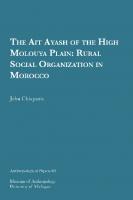The Ait Ndhir of Morocco: A Study of the Social Transformation of a Berber Tribe 9780932206534, 9781951519162
This work is an enquiry into the nature of tribalism in Morocco and its historical relationship to the central governmen
342 81 8MB
English Pages [143] Year 1974
Table of Contents
Introduction
I. French Conceptual Frameworks and Moroccan Reality
The Makhzan-Siba Dichotomy
The Phenomenon of Berberism
II. History of the Ait Ndhir
The General Ethnohistorical Background
The Nineteenth Century
The Ait Ndhir and the Alawi Dynasty
The Ait Ndhir at the Beginning of the Twentieth Century
III. Ecology and Traditional Economic Organization
The Ecological Setting
The Tribal Territory
Traditional Economy of the Ait Ndhir
The Seasonal Migration
Forms of Economic Cooperation
IV. Sociopolitical Organization
Alternative Frameworks: Segmentation Versus Alliance
What Was an Ait Ndhir Tribe?
The Dynamics of Intra-Tribal Relationships
Pacts of Brotherhood and Protection
Violence and the Moral Order
The Social Order of the Ait Ndhir: Concluding Remarks
V. The Dynamics of Traditional Land Tenure and Tribal Organization
The Makhzan Land Tenure System
Guish and Naiba Tribes
The 'Azib Institution
Tribal Tenure: Collective Land
Land Tenure and Land Use Among the Ait Ndhir
The Ait Ndhir Tribe: An Adaptive Interpretation
VI. The French Protectorate and Land Colonization
French Order: The Legal Labyrinth
The Case of the Ait Ndhir: "Un guich fictif"
Unanticipated Consequences: Arabization and Residual Tribalism
VII. Conclusion
Appendix I
Appendix II
Appendix III
Appendix IV
Appendix V
Bibliography
Recommend Papers

File loading please wait...
Citation preview
THE AIT NDHIR OF MOROCCO: A STUDY OF THE SOCIAL TRANSFORMATION OF A BERBER TRIBE
~
:;: Q)
-:S
.....
o s:: Q)
~
~
~ ~
Q) CI.l
ANTHROPOLOGICAL PAPERS
MUSEUM OF ANTHROPOLOGY, UNIVERSITY OF MICHIGAN NO. 55
THE All NDHIR OF MOROCCO: A STUDY OF THE SOCIAL TRANSFORMATION OF A BERBER TRIBE
BY AMAL RASSAM VINOGRADOV
ANN ARBOR THE UNIVERSITY OF MICHIGAN, 1974
© 1974 by the Regents of the University of Michigan The Museum of Anthropology All rights reserved ISBN (print): 978-0-932206-53-4 ISBN (ebook): 978-1-951519-16-2 Browse all of our books at sites.lsa.umich.edu/archaeology-books. Order our books from the University of Michigan Press at www.press.umich.edu. For permissions, questions, or manuscript queries, contact Museum publications by email at [email protected] or visit the Museum website at lsa.umich.edu/ummaa.
ACKNOWLEDGMENTS I wish to thank the Center for Near Eastern and North African Studies for the financial support that made my field work possible, and for supporting the publication of this monograph. I feel a special debt of gratitude to the Director of the Center and my advisor, William D. Schorger, who introduced me to North African Studies and encouraged me throughout my graduate work at The University of Michigan. Many people have contributed directly and indirectly to this study. I received invaluable advice and help from Eric Wolf, John Waterbury, Ernest Gellner, Remy Leveau, David Hart, and Ernest Abdel-Massih. My fellow fieldworkers-Lawrence Rosen, Edmund Burke, and John Chiapuris-were very generous in sharing their ideas and field notes. To them all my sincere thanks. Of the many Moroccans who helped me, I wish to single out Hajj Mohktar Amharesh and qaid Mohand n'Hamoucha of the Ait Ndhir. They graciously put up with my female presence in their jma'as and patiently made me understand and appreciate their vanished way of life. I remember with great affection the women of the bled-Malika, Touria, Fadma and Amina-and all the others who took me in as a friend, confidante, and "sister." Their trust and concern made my stay less lonely. To my husband and children, whose interest, encouragement, and sacrifice saw me through the difficult times, I dedicate this work.
v
A NOTE ON TRANSLITERATION I have attempted to be both phonologically accurate and consistent without deviating too much from the French transliteratiori system that has become standard for Morocco. The deviations that do occur were felt to be necessary for the sake of accuracy, e.g., the Moroccan Arabic word for "army" has been transliterated in French literature as "guich." It appears in this study as "guish," a compromise for a better English transliteration. The author is aware of the fact that neither the form "guich" nor "guish" is really accurate. The correct form as heard in Morocco and as recorded on my field tapes is jish-zis. However, to use this latter correct form at this time would lead to further confusion in an area already confused.
Correspondence of Modern Standard Arabic script and symbols used in the transcription Symbol Used
Arabic Script
t.
kh gh
...
sh
Lr
q
vi
A PARTIAL GLOSSARY OF ARABIC TERMS* 'alem/'ulemal 'askari/'askar/ 'azib baraka bled-blad-bilad c;lahir dir diyya douar fekhda/afkhad ferqa fqih guish_guich_ar. jish iqta' khalifa kharaj leff-Heff makhzan -makhzen mulk qagi qaid q~ba_qa~ba
shari 'a_ chraa sharif Ish urfal siba souq_ssouq tartib -tertib 'urf zawiya/zawayal
religious savant soldiers landholding, rural estate quality of blessedness or holiness countryside, country imperial edict mountain slope blood money rural settlement lineage, clan, tribal segment tribal section religious teacher army land concession deputy land tax alliance central government of Morocco private property religious judge rural administrator fortified town, citadel Islamic religious law descendant of the Prophet dissidence market agricultural tax customary law religious order
*In th~s and ~he .following glossary of Berber terms, plural forms are listed after a / line follOWIng therr SIngular forms. The symbol-denotes a variant either in transliteration or form. The term Arabic, symbolized here as ar., refers to Moroccan Arabic.
vii
A PARTIAL GLOSSARY OF BERBER TERMS abrid agdal akhatar likhatarenl amghar limgharenl amur .
5
Fig. 4. Economy of the Middle Atlas (from Geographie du Maroc, pp. 124-125).
PLATEAU CENTRAL
50Km
Central,s hydn:lilectnques
;", .. PrlnClpoux aXil!; de parcours
~~I'VOII.. eKteflSJf{ovlns)
t:::=:jTerroTns dill parcours
E:3 ~1.voge,a5S0CI' aUK cultures b;;;;;;;j dons Tes vollhs(sid,ntOlrllSj
. _.
D
::--:::>:._::.:.
r:-'" ::: ':< 1CuttUI1I!> c'r'oh,,"es
~'rr'9uhs
-J
'"
z
o
~
N
Z ,....,
~
::0
o
(j
z ~ ,....,
o
tJ:j (j
> t-
t:t
::0
I-j
t:t
> Z
>





![The Samburu: A Study of Gerontocracy in a Nomadic Tribe [Reprint 2019 ed.]
9780520337091](https://ebin.pub/img/200x200/the-samburu-a-study-of-gerontocracy-in-a-nomadic-tribe-reprint-2019nbsped-9780520337091.jpg)



